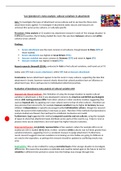Van Ijzendoron’s meta-analysis: cultural variations in attachment
Aim: To investigate the types of attachment across cultures and to see how the three main
attachment styles applied. To investigate if attachment styles (secure and insecure) are
universal (the same) across cultures, or culturally specific.
Procedure: Meta analysis of 32 studies into attachment research in style of ‘the strange situation’ in
8 different countries, the US being studied the most, this was done between cultures and within
cultures (cross cultural)
Findings:
Secure attachment was the most common in all cultures, though lowest in China (50% of
those studied)
Secure attachment was highest In Great Britain (75%)
Insecure avoidant was more common in Germany (35%) and rarest in Japan (5%)
Insecure resistant was highest in Israel (29%)
Recent research: Simonelli (2014): conducted in Italy to find cultural variations, and found out of 76
babies only 50% had a secure attachment, whilst 36% had an insecure attachment
Conclusions: Secure attachment appears to be the norm in many cultures, supporting the idea that
attachment is innate, however research clearly shows that cultural practises have an influence on
attachment type, this is perhaps due to individualist/collectivist practises.
Evaluation of Ijzendoorns meta-analysis of cultural variation-A03
Imposed etic/biased method : One limitation of using the strange situation to explain cultural
variation in attachment, is that it was developed in America by American and British psychologists
where child rearing practises differ from other cultures in other countries studied, suggesting they
used an imposed etic, by applying one’s own cultural norms to that of other cultures , therefore we
may perceive them incorrectly, for example Insecure avoidant may be higher in Germany because
children’s independence is typically encouraged earlier(individualistic culture), though the research
makes the parent-child relationships in Germany as poor, Therefore if the methods that Ijizendoorns
analysis studied was flawed, then perhaps his variational conclusions are invalid.
Furthermore: Sagi suggested this method compared countries and not cultures, using the example
of Japan to show that attachment types distribute across parts of the country e.g., Tokyo is rural so
possess more secure attachment, but rural Japan has higher insecure resistance.
Representativeness: not globally representative of less western culture for example Africa is not
studied yet USA is studied 18/32 times, further, variations within cultures was 1.5 times greater than
variations between, suggesting it isn’t a consistent measure to judge attachment. Furthermore,
recent research suggests insecure avoidance is increasing as more babies are going to childcare so
are used to the separation, so perhaps this research should be updated as conflicting results may
arise.
Replicability: This can be credited for using a controlled basis of the strange situation to investigate
differences, this means the procedure is replicable and could be tested again in the future to test for
reliability in different time periods to assess how the findings may change through time.





